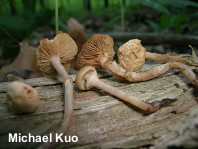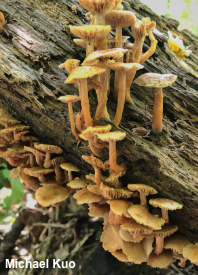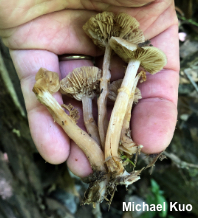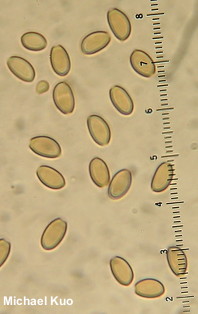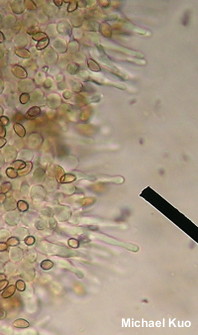| Major Groups > Gilled Mushrooms > Dark-Spored > Pholiota > Kuehneromyces marginellus |

|
[ Basidiomycota > Agaricales > Strophariaceae > Kuehneromyces . . . ] Kuehneromyces marginellus by Michael Kuo, 25 April 2023 Also known as Kuehneromyces rostratus and Pholiota veris, this little species is an eastern, hardwood-rotting pholiotoid mushroom that appears in late spring, just after morel season. It features a bald, buffy-brown cap, gills that are attached to the stem, a fairly smooth stem surface, and a distinctive thin ring that initially flares upward, then collapses and develops a tawny brown edge. The spore print is brown. Under the microscope Kuehneromyces marginellus features funky, long-necked cheilocystidia. Kuehneromyces mutabilis is somewhat similar, but it appears in summer and fall, and features a scaly stem. Kuehneromyces lignicola (also known as Kuehneromyces vernalis or Pholiota vernalis) is very similar and does appear in spring (as well as summer and fall), but is usually found on conifer wood; it has a skinnier stem and shorter, fatter cystidia that sometimes develop apical projections. Description: Ecology: Saprobic; growing alone, scattered, or in clusters on the well decayed wood of hardwoods (especially oaks and beech); late spring; originally described from New York (Peck 1898); widely distributed in North America east of the Great Plains. The illustrated and described collections are from Illinois. Cap: 1–4 cm; convex or almost conical at first, becoming broadly convex or nearly flat; sticky when fresh; tan to snuff brown, fading markedly as it dries out and eventually becoming buff colored; bald. Gills: Narrowly to broadly attached to the stem; close; short-gills frequent; whitish to yellowish or pale tan when young, becoming cinnamon brown; hygrophanous; at first covered by a whitish partial veil. Stem: 2.5–7 cm long; 3–6 mm thick; equal or tapering slightly to base; dry; with an upward-flaring, whitish to pale tan ring that soon begins to collapse and develop a tawny brown edge; pale tan; bald or with inconspicuous fibrils just below the ring. Flesh: Yellowish to pale brownish. Odor and Taste: Not distinctive. Chemical Reactions: KOH negative on cap surface. Spore Print: Brown to cinnamon brown. Microscopic Features: Spores 5.5–9 x 3.5–5 µm; ellipsoid; with a pore 0.5–1 µm wide; smooth; yellowish with brown walls in KOH; yellowish in Melzer's. Basidia 25–28 x 5–6 µm; 4-sterigmate. Cheilocystidia 25–45 x 2.5–7.5 µm; cylindric to clavate or lageniform; flexuous; often with subcapitate to capitate apices; hyaline in KOH; thin-walled; smooth. Pleurocystidia not found. Pileipellis an ixocutis; elements 2.5–10 µm wide, smooth, hyaline to yellowish or golden in KOH. REFERENCES: (Peck, 1898) Redhead, 1984. (Saccardo, 1902; >Singer & Smith, 1946; Smith & Hesler, 1968; Roody, 2003; Kuo & Methven, 2014; McKnight et al., 2021.) Herb. Kuo 05169508, 05100702, 05252001. This site contains no information about the edibility or toxicity of mushrooms. |
© MushroomExpert.Com |
|
Cite this page as: Kuo, M. (2023, April). Kuehneromyces marginellus. Retrieved from the MushroomExpert.Com Web site: http://www.mushroomexpert.com/kuehneromyces_marginellus.html |
